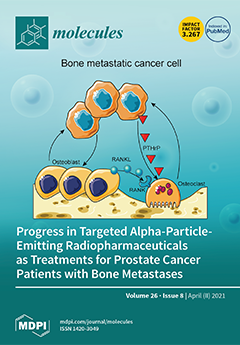Ten benzoxazole clubbed 2-pyrrolidinones (
11–
20) as human monoacylglycerol lipase inhibitors were designed on the criteria fulfilling the structural requirements and on the basis of previously reported inhibitors. The designed, synthesized, and characterized compounds (
11–
20) were
[...] Read more.
Ten benzoxazole clubbed 2-pyrrolidinones (
11–
20) as human monoacylglycerol lipase inhibitors were designed on the criteria fulfilling the structural requirements and on the basis of previously reported inhibitors. The designed, synthesized, and characterized compounds (
11–
20) were screened against monoacylglycerol lipase (MAGL) in order to find potential inhibitors. Compounds
19 (4-NO
2 derivative) and
20 (4-SO
2NH
2 derivative), with an IC
50 value of 8.4 and 7.6 nM, were found most active, respectively. Both of them showed micromolar potency (IC
50 value above 50 µM) against a close analogue, fatty acid amide hydrolase (FAAH), therefore considered as selective inhibitors of MAGL. Molecular docking studies of compounds
19 and
20 revealed that carbonyl of 2-pyrrolidinone moiety sited at the oxyanion hole of catalytic site of the enzyme stabilized with three hydrogen bonds (~2 Å) with Ala51, Met123, and Ser122, the amino acid residues responsible for the catalytic function of the enzyme. Remarkably, the physiochemical and pharmacokinetic properties of compounds
19 and
20, computed by QikProp, were found to be in the qualifying range as per the proposed guideline for good orally bioactive CNS drugs. In formalin-induced nociception test, compound
20 reduced the pain response in acute and late stages in a dose-dependent manner. They significantly demonstrated the reduction in pain response, having better potency than the positive control gabapentin (GBP), at 30 mg/kg dose. Compounds
19 and
20 were submitted to NCI, USA, for anticancer activity screening. Compounds
19 (NSC: 778839) and
20 (NSC: 778842) were found to have good anticancer activity on SNB-75 cell line of CNS cancer, exhibiting 35.49 and 31.88% growth inhibition (% GI), respectively.
Full article






